I find that the bluish-gray-green narrow leaves and gnarled, curving branches give Santa Cruz Island buckwheat (
Eriogonum arborescens) an exotic air. Island buckwheat has a symmetrical, compact mounding habit, while its flat flower umbels have a handsome asymmetry.
A striking plant year-round, island buckwheat is especially outstanding in the summer and fall. Its creamy white flowers kissed with pink bloom profusely through summer, then slowly change to deep rust seed heads through fall. I have a special fondness for island buckwheat when it’s wet with rain; it’s almost magical, with seed heads that seem to deepen to burnt orange and chocolate colors that resonate in contrast to the gray day.
Not in California? Browse plants native to more regions of the U.S.
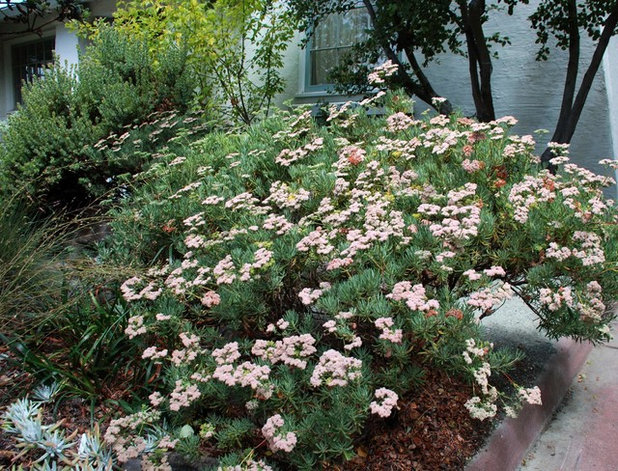
Pete Veilleux, East Bay Wilds
Botanical name: Eriogonum arborescensCommon name: Santa Cruz Island buckwheat, island buckwheat
Origin: Native to the Channel Islands, except San Miguel Island, off the coast of Santa Barbara in California
Typical plant communities: Coastal bluffs, rocky slopes, grassy hillsides, coastal scrub, chaparral and grasslands below 500 feet
Where it will grow: Easily hardy to 30 degrees Fahrenheit, but can tolerate down to 0 degrees Fahrenheit (USDA zones 7 to 10; find your zone)
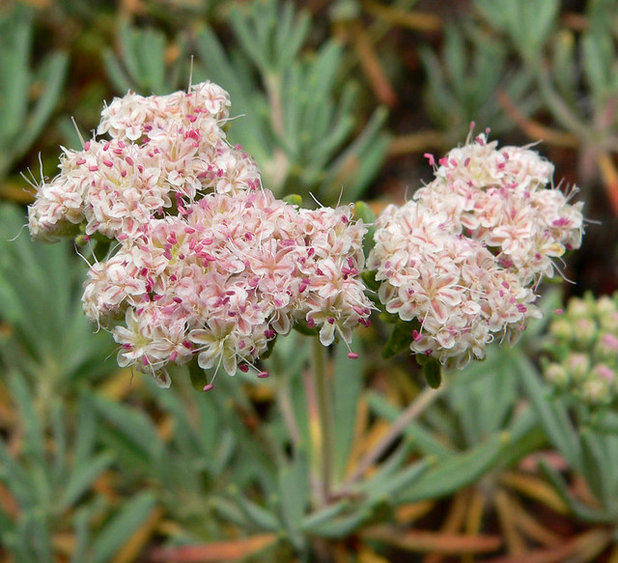 Water requirement:
Water requirement: Drought-tolerant once established; water every three to four weeks or not at all
Light requirement: Full sun to partial shade; will have a better shape in full sun
Soil: Requires well-drained soil, otherwise adaptable; tolerates clay and alkaline soils
Mature size: At least 2 to 4 feet tall and wide
Photo by Stan Shebs
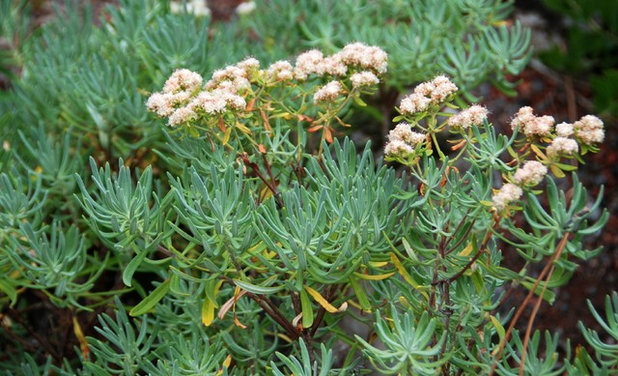
Pete Veilleux, East Bay Wilds
Benefits and tolerances: Benefits native bees, butterflies, birds and other small animals; great for slope stabilization; works well in containers; tolerates hard frost, seaside conditions, alkaline soil and clay; highly resistant to deer
Seasonal interest: Profuse summer blooms; rust-colored seed heads from fall through winter; striking trunk, branches and foliage year-round
When to plant: Late fall is ideal; winter works well; spring is acceptable; summer can be challenging to all but the most experienced gardener
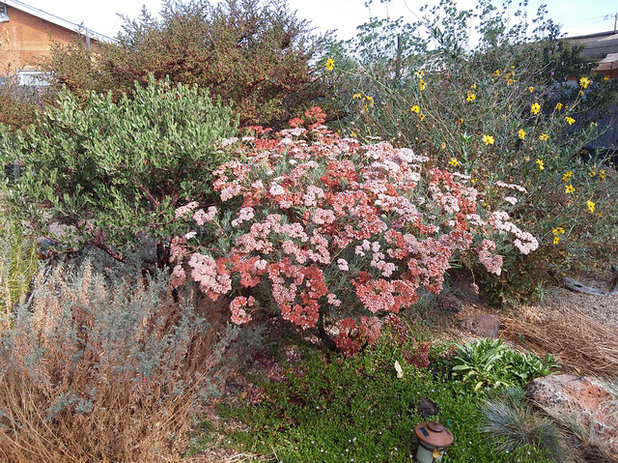
Debbie Ballentine
Distinguishing traits. Island buckwheat has a compact mound of gray green needle-like foliage and gnarled branches.
The vibrant rust-colored seed heads, seen on the island buckwheat above during fall, start as a profuse summer bloom of white to pinkish flowers. Although most stunning in summer and fall, island buckwheat is reliable and stately all year.
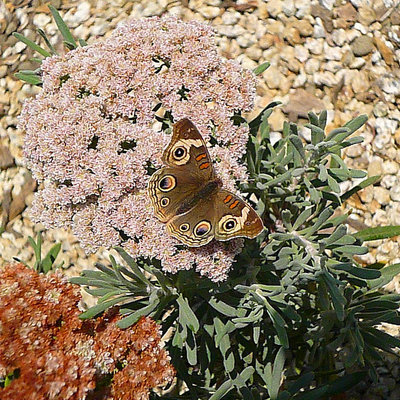
Debbie Ballentine
Wildlife value. Island buckwheat is an important habitat plant. As with many buckwheats, it provides food and shelter for lots of critters, large and small.
It is a riot of pollinators throughout its flowering season, from the teensiest native bees and chubby long-horn bees to stunning black wasps (who never bother people and only prey on garden pests) and enchanting butterflies, like hairstreaks, blues and even an occasional buckeye, like the one shown.
Birds and small animals hide among the dense branches, search for insects under and in the plant, and eat the profuse seeds during the fall and winter, when other foods are limited.
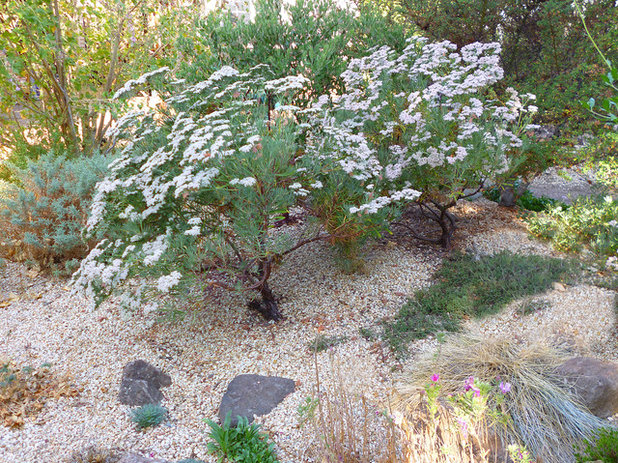
Debbie Ballentine
How to use it. The two island buckwheats shown here have been skirt-pruned to reveal their attractive trunks and branches and to provide space for the lowest-growing plants, such as certain species of coyote brush (
Baccharis spp.), manzanita (
Arctostaphylos spp.), turkey tangle fogfruit (
Phyla nodiflora syn.
Lippia repens) and even nonnative creeping thyme (
Thymus spp.).
As long as it is provided with well-drained soil, island buckwheat is flexible in nearly any situation. It can be particularly stunning in a small garden when skirt-pruned and used as a single focal plant. In moderate to large gardens, plant it individually, in small groups or in a mass. Island buckwheat can also be planted as a reliable unclipped hedge and can even make a statement in a container. Buckwheats look great with other California natives that bloom during other times of the year, such as ceanothus (
Ceanothus spp.), sage (
Salvia spp.) and manzanita (
Arctostaphylos spp.).
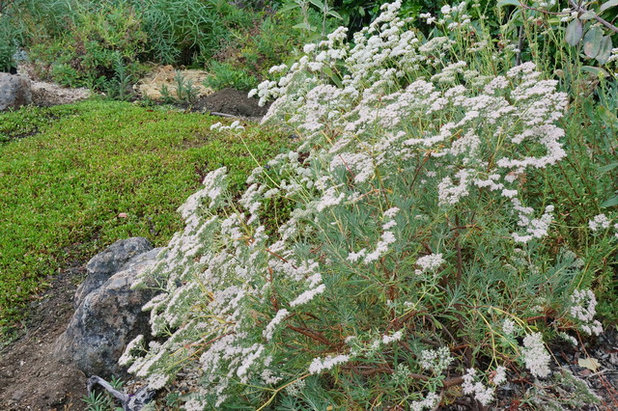
Debbie Ballentine
Planting notes. Island buckwheat is self-reliant and needs nearly no maintenance. Feel free to prune off the finished seed head stalks in the fall or winter. Deadheading after flowering can sometimes stimulate another bloom in the fall.
When the spring or summer is particularly cool, island buckwheat can get a case of downy mildew.
If you find in spring that you have dozens of volunteer baby buckwheats, transplant or pot up a few to replace older plants. If you want to reduce the number of volunteer plants, simply prune off half of the seed heads in fall, which will leave plenty of seeds for the critters. I usually leave the seed heads and simply pull out the volunteers in spring.
More How to Design a Garden for Native Bees
Browse plants native to other regions of the U.S.





